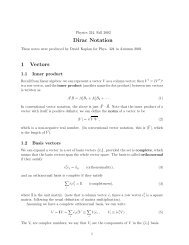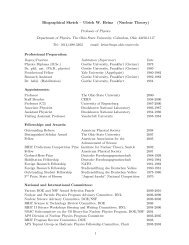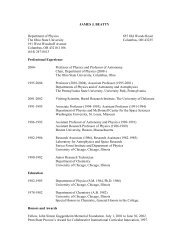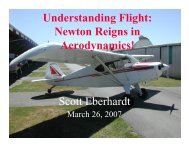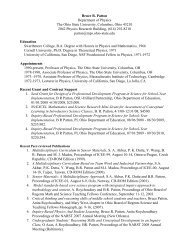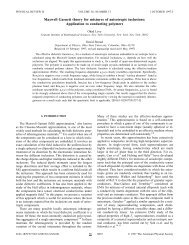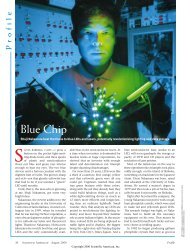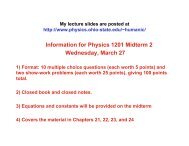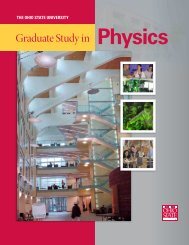Waves Particlelike Properties of Waves and Wavelike Properties of ...
Waves Particlelike Properties of Waves and Wavelike Properties of ...
Waves Particlelike Properties of Waves and Wavelike Properties of ...
You also want an ePaper? Increase the reach of your titles
YUMPU automatically turns print PDFs into web optimized ePapers that Google loves.
What you should know about . . .<br />
<strong>Waves</strong><br />
1. Basic wave properties [Q1]<br />
• Superposition principle holds if wave equation is linear<br />
• f = ω/2π, λ = 2π/k, wave speed v = fλ = ω/k<br />
• What does wave velocity depend on? e.g., string: tension <strong>and</strong> mass per unit length<br />
• What is resonance?<br />
• Finding normal modes (as in homework): boundary conditions, counting wavelengths<br />
• Fourier series: a periodic function can be uniquely decomposed into a sum <strong>of</strong> sines <strong>and</strong> cosines<br />
2. Interference phenomena [Q2,Q4]<br />
• Diffraction through or around object (slit, eyeball, etc.) with size a<br />
– total diffraction if λ > a; no diffraction if λ ≪ a<br />
– Construction using path difference to derive sin θ = λ/a formula for first minimum.<br />
– When can objects be resolved? (qualitative <strong>and</strong> quantitative)<br />
• Applying two-slit interference formula<br />
– Construction using path difference to derive formula for “bright spots”: d sin θ = nλ<br />
• When is the small-angle approximation (sin θ ≈ tan θ ≈ θ) valid?<br />
What you should know about . . .<br />
<strong>Particlelike</strong> <strong>Properties</strong> <strong>of</strong> <strong>Waves</strong> <strong>and</strong> <strong>Wavelike</strong> <strong>Properties</strong> <strong>of</strong> Particles<br />
1. Photon model [Q3]<br />
• photon energy/momentum related to frequency <strong>and</strong> wavelength<br />
• Basic relations for photons: E = hf = hc/λ; E = pc<br />
• Basic photon calculations (photons per second emitted, absorbed, visible photon wavelengths, etc.)<br />
2. Photoelectric effect [Q3]<br />
• predictions <strong>of</strong> wave vs. particle models [also Q5,Q6]<br />
• analysis <strong>of</strong> experiment: K = hf − W = hc/λ − W<br />
• What is a work function?<br />
3. de Broglie wavelength: what does it mean? [Q4,Q5]<br />
• p = h/λ <strong>and</strong> E = hf (E ≠ hc/λ for massive particles!). Nonrelativistic free particle: E = p 2 /2m<br />
• relationship between kinetic energy <strong>and</strong> wavelength (qualitative <strong>and</strong> quantitative)<br />
– nonrelativistic: λ = h/ √ 2Km = hc/ √ 2Kmc 2 . Relativistic version: λ = hc/ √ K(K + 2mc 2 )<br />
• diffraction <strong>and</strong> interference <strong>of</strong> particles<br />
– occurs when deBrogle λ comparable to slit size or other relevant size.<br />
– applications: electron interference experiments, resolving particles (λ a)
What you should know about . . .<br />
1. Probability interpretation <strong>of</strong> wave function [Q6]<br />
Quantum Mechanics<br />
• Calculating the probability to find a particle in some region <strong>of</strong> space (given a wave function)<br />
• Possible results <strong>of</strong> successive measurements <strong>of</strong> an observable (e.g., energy or position); “collapse”<br />
2. The probability rule <strong>and</strong> application to spin wave functions [Q6]<br />
• If you have quanta in a state |ψ〉 <strong>and</strong> measure an observable O <strong>of</strong> the quanta which has possible<br />
eigenvalues O n , n = 1, 2, 3, . . . , then the probability that your measurement yields the specific value O n<br />
for the observable is<br />
P r(O n ) = |〈O n |ψ〉| 2 ,<br />
with |O n 〉 being the eigenstate <strong>of</strong> the observable O with eigenvalue O n .<br />
3. Time Dependence <strong>of</strong> a stationary state [∝ e −iEnt/ ] [Q6]<br />
• When is a solution a “stationary state”? [Definite energy =⇒ energy eigenfunctions!]<br />
• What happens if you combine two stationary states?<br />
4. Quanton in a Box [Q7]<br />
• derivation <strong>of</strong> energy eigenvalues E n = h 2 n 2 /8mL 2 <strong>and</strong> eigenfunctions ψ E (x) = A sin(nπx/L) in box<br />
5. Bohr model assumptions =⇒ energy levels E n = −ke 2 /2a 0 n 2 <strong>and</strong> radii r n = n 2 a 0 in hydrogen [Q7]<br />
• Bohr radius a 0 = h 2 /4π 2 mke 2 ≈ 0.053 nm =⇒ E n = −(13.6 eV)/n 2 . Results for hydrogen-like atoms.<br />
6. Photon spectral lines [Q8]<br />
• Relationship to energy levels (differences!)<br />
• Infinite well vs. oscillator vs. hydrogen atom (energy levels <strong>and</strong> spectra)<br />
• Pauli exclusion principle <strong>and</strong> spin; fermions vs. bosons<br />
7. Atoms [Q9]: Selection rules (e.g., ∆l = ±1), predicting ground state configuration, periodic table <strong>of</strong> elements<br />
What you should know about . . .<br />
Energy Eigenfunctions [Q10, Q11]<br />
1. Schrödinger eq: − 2 d 2 ψ E (x)<br />
2m dx<br />
+ V (x)ψ 2<br />
E (x) = Eψ E (x). Is a given function a possible energy eigenfunction?<br />
2. ψ E (x) is wavelike (curving towards the axis) in a classically allowed region (V (x) < E)<br />
3. The local curvature (2nd derivative!) is related to the local wavelength which is related to the local kinetic<br />
energy K(x) = E − V (x) (see equations on previous page <strong>and</strong> K = h 2 /2mλ 2 ).<br />
4. ψ E (x) is exponential-like (curving away from the axis) in a classically forbidden region (V (x) > E)<br />
5. The wavefunction must decay to zero at |x| → ∞ (normalizability!).<br />
6. This causes quantization <strong>of</strong> energy: Only for specific values <strong>of</strong> E does the wavefunction curve in the<br />
classically forbidden region in exactly the way needed for the wavefunction to approach zero at |x| → ∞.<br />
7. The quanta spend more time in regions where they move slowly (small K(x)) – wave function has larger<br />
amplitude there.<br />
8. Tunneling: the ability <strong>of</strong> a wavefunction to leak through a finite barrier due to its exponential tail in the<br />
classically forbidden region.



